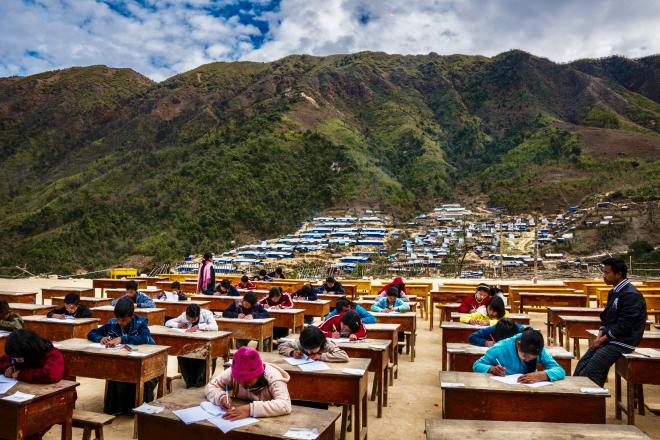|
|
|
Concerns are deepening in the Kachin and Shan States as the government seeks to close internal displacement camps while conflict continues and the coronavirus is still spreading. War-shattered communities face a highly uncertain future. This commentary reports on a new initiative by civil society organisations to ensure that the human rights and security of IDPs are protected. But without peace and political reform, there are many worries that the crisis will only continue.
These commentaries are intended to contribute to a broader understanding to the many challenges facing the country and its peoples.
See the complete list of all the Myanmar commentaries.
|
|
|
|
 School students sit their exams in an IDP camp, Kachin State / Photo credit Airavati School students sit their exams in an IDP camp, Kachin State / Photo credit Airavati
|
|
|
|
|
|
|
| |
| “The cycles of conflict and displacement must be brought to an end”: The IDP crisis in northeast Myanmar |
|
A Commentary by Lahpai Seng Raw
30 March 2020
In mid-March, over 100 representatives of civil society groups, local and international non-governmental organisations, the United Nations, Western embassies and other international agencies met in Myitkyina at a conference hosted by the Kachin Humanitarian Concern Committee and Joint Strategy Team.1 Entitled the “Internally Displaced Persons-Related Multi-Stakeholder Meeting for Kachin and Northern Shan States”, the purpose was to discuss government plans to close the camps that house over 100,000 civilians who have been displaced from their homes since the resumption of conflict after 17 years of ceasefire between the government and Kachin Independence Organisation in June 2011.2
Discussions were wide-ranging. Concerns were deeply expressed by local participants about the continuing conflict, the vulnerability and insecurity of IDPs, the loss of land and homes and the problematic legal framework,3 the dangers from landmines, and the lack of inclusive political and economic reform. There was also anxiety in local communities about the threat of the Covid-19 virus for which IDPs are very under-prepared. On every level, IDPs are in a very challenging position after many years of conflict and displacement. But, if effective and meaningful solutions are to be found, there was one common theme: IDPs need to be full participants at the centre of discussions and decisions that will affect their lives.
The following is an edited version of the opening remarks to the meeting by Lahpai Seng Raw.
Following the ceasefire era that began in the early 1990s, I found myself engaged head-on in initiating contacts and supporting the rehabilitation and resettlement of around 10,000 Kachin refugees who were taking sanctuary across the border in China. These events occurred not far from the Multi-Stakeholder Meeting in Myitkyina. Thirty years later, it is a tragedy of the greatest proportions to be witnessing the same crisis in humanitarian emergency – only, this time, the scale of displacement is more than tenfold higher. Currently, there are over 107,000 internally displaced persons recorded in 173 camps in Kachin State and northern Shan State.
This experience means that we must take a very sober assessment of the realities that all the peoples of the Kachin and northern Shan States are presently facing. It needs to be remembered that, when war resumed again in the two territories in 2011, many local people fled again to China. This time, however, the Chinese authorities pushed them back to Myanmar, and the international human rights principle of “non-refoulement” was violated. As a result, many Kachins and other local peoples became IDPs in their own country without the protection that international Refugee Law should provide them.
|
|
|
|
|
|
| |
|
|
|